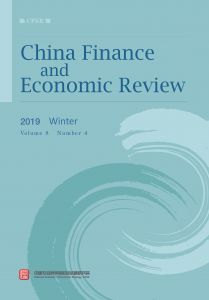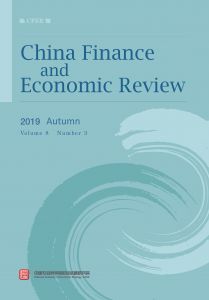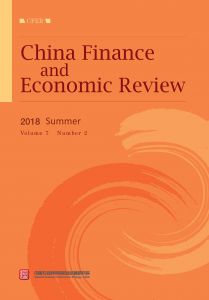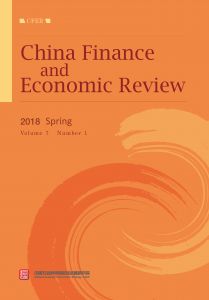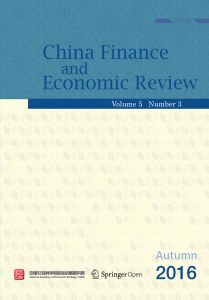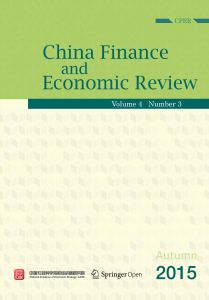最新期刊
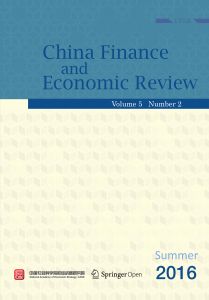
目录
过往期刊
参考文献
-
Instructions for Authors
-
编委会
-
Status analysis and control measures of the debt risk in Chinese local government: based on the study of the relationship among “power, responsibility and interests”
-
1. Background
-
2. The evaluation on the debt scale and risk in our local governments
-
3. Analysis on the debt risk of Chinese local government: based on the relationship among “power, responsibility and interests”
-
4. Preventing and controlling the debt risk of local government: realization of the relationship coordination among “power, responsibility and interests”
-
5. Conclusions
-
-
Examining volatility spillover between Asian stock markets
-
1. Background
-
2. Literature Review
-
3. Methods
-
4. Empirical results
-
5. Conclusions and implications
-
-
China’s structural transformation: reaching potential GDP in the financial services sector
-
1. Background
-
2. Structural change, TFP and growth
-
3. Structural change theory and application to China
-
4. China’s financial sector
-
5. Methods and results: modelling financial sector potential
-
6. Discussion and policy recommendations
-
7. Conclusion
-
-
Why rapid urbanization can’t improve employment absorption capacity of service industry in China: reflections on innovating the model of interaction between service industry development and urbanization under economic transformation and upgrading
-
1. Introduction
-
2. The theory analysis of how the urbanization process influence the service employment absorption
-
3. Descriptive statistics
-
4. Empirical test
-
5. Further analysis of the empirical test results
-
6. Main conclusions and policy implication
-
-
From imitation to innovation
-
1. Introduction
-
2. Analysis on the model reflecting the effect of IPP upon the interests of enterprises and consumers
-
3. The characteristics of building an innovation-oriented country and the optimal intellectual property protection
-
4. The judgment on the phase of building China into an innovation-oriented country
-
5. The approach to realize optimal IPP strength in building an innovation-oriented country
-
-
Research on the phase characteristics and driving mechanism of Chinese business cycle fluctuation
-
1. Issues stressed and literature review
-
2. The state transition of economic cycle fluctuation and construction of driving mechanism model
-
3. The estimation of output gap, output expectation and the influence factor on transition probability
-
4. Analysis of the operation characteristics in the economic cycle stages by MS-TVTP model
-
5. Researches on the driven factors of economic cycle fluctuation based on the classification of the leading synthetic index
-
6. Conclusion and policy recommendations
-
-
Retirement delay unified or differentiated
-
1. Introduction
-
2. Literature review
-
3. Research hypothesis and the model
-
4. Selection mechanism of the retirement delay
-
5. Data simulation
-
6. Conclusion and revelation
-
按年份浏览:
- 全部
- 2020
- 2019
- 2018
- 2017
- 2016
- 2015
- 2014
- 2013
[1][1]Cai, Y. (2011). Current situation, causes and countermeasures of local government debt. Public Finance Research , 9, 5-7.
[2][2]Fu, R. M., Miao, X. L., Wang, M., & Yang, Y. Q. (2013). Construction of the mechanism of China’s public financial security monitoring and early-warning: a theoretical research framework. Finance & Trade Economics (Caimao Jingji) , 8, 18-26+17.
[3][3]Guo, R. (2009). The parity of authority and responsibility: dissimilation and remediation. Journal of Shenyang Normal University (Social Science Edition) , 2, 28-31.
[4][4]Huang, G. Q., & Xu, Y. S. (2011). Analysis on the transmission mechanism and formation mechanism of local government debt risk. Public Finance Research (Caizheng Yanjiu ), 9,2-5.
[5][5]Islam, M. F., & Hasan, M. S. (2007). The macroeconomic effects of government debt on capital formation in the united states: an empirical investigation. Manchester School, 75 (5), 598-616.
[6][6]Jhering, R. V., (2012). Fighting for Rights . The Law Press.
[7][7]Levine, H. (21011). The impact of debt management policies on borrowing costs Incurred By U.S. state governments. Public Finance & Management , 11 (1), 1-27.
[8][8]Li, T., (2012). The leading of institute . The Press of China National School of Administration.
[9][9]Liu, Y. H. (2013). Debt soft constraint to weaken monetary control. http://www.chinabond.com.cn/Info/15715573 , 4,3.
[10][10]Ma, B. B., & Guo, R. (2010). Equality or inequality of rights and responsibilities: theory vs reality. Cass Journal of Political Science (Zhengzhixue Yanjiu ),1, 72-78.
[11][11]Miao, X. L., & Fu, R. M. (2012). Formation and measure of the debt risk of local government in China: a study based on empirical data from one western province. Finance & Trade Economics (Caimao Jingji ) 1, 17-24.
[12][12]Miao, X. L., & Fu, R. M. (2015). Division of powers and responsibilities, background of political performance and extraordinary growth of local government debt. Finance & Trade Economics (Caimao Jingji ), 4,17-31.
[13][13]Mikesell, J. L. (2002). The threat to state sales taxes from e-commerce: a review of the principal issues. Municipal Finance Journal , 23 (3), 48-61.
[14][14]Qi, D. J. (2001). On power. Chinese Journal of Law (Faxue Yanjiu ), 1, 18-32.
[15][15]Qi, M. S., & Li, Y. Y. (2006). Public administrative value, public interest and public responsibility—a three dimensional structure of scientific operation of public power. Academics in China , 6, 28-35.
[16][16]Qi, Z. H. (1988). Philosophy of management . The Press of Chinese Academy of Social Science.
[17][17]Wang, F. F. (2000). On the principle of responsibility in accord with authority. Journal of Guangdong Institute of Public Administration (Guangdong Xingzhengxueyuan Xuebao ), 4, 16-17.
[18][18]Wang, H. Y. (1994). Principles of politics . Higher Education Press.
[19][19]Wei, X. H., & Chen, H. S. (2005). The government responsibility and the local management . The Press of Party School of the Central Committee of C.P.C.
[20][20]Wu, Q., & Ma, X. M. (2011). Research on the local government debt issues in the developed coastal areas under the new situation— a case study of part of counties (cities) in Wenzhou and Suzhou. Review of Economic Research (Jingji Yanjiu Cankao ),10, 18-28.
[21][21]Xie, S., & Bai, Y. J. (2013) Analysis on local government financing platform—credit accelerator effect under the dual impulse. Economic Theory and Business Management (Jingjililun yu Jingjiguanli ), 1,60-68.
[22][22]Yang, C. M., & Lu, Y. P. (2013). Current situation, causes and Countermeasures of local government debt risk. Public Finance Research (Caizheng Yanjiu ),11,58-60.
[23][23]Yang, S.E., & Li, S.P. (2013). The determine of local government debt: an institutional framework, Reform of Economic System (Jingji Tizhi Gaige ), 2, 15-19.
[24][24]Baele, L. (2002). Volatility spillover effects in European equity markets: evidence from a regime switching model. Ghent University, Working Paper , 1-62.
[25][25]Beirne, J., Caporale, G. M., Schulze-Ghattas, M., & Spagnolo, N. (2009). Volatility spillovers and contagion from mature to emerging stock markets. Working Paper series , 1113, 1-48.
[26][26]Choo, W.C., Loo, S. C., Ling, L. B., & Ung, S. N. (2011). Return and volatility spillover between large and small stocks in Bursa Malaysia. International Journal of Business and Social Science, 2 (1), 76-185.
[27][27]Chou, R. Y., Lin, J. L., & Wu, C. S. (1999). Modeling the Taiwan stock market and international linkages. Pacific Economic Review , 4 (3), 305-320.
[28][28]Dickey, D. A., & Fuller, W. A. (1979). Distribution of the estimators for autoregressive time series with a unit root. Journal of the American statistical association , 74 (366a), 427-431.
[29][29]Diebold, F. X., & Yilmaz, K. (2009). Measuring financial asset return and volatility spillovers, with application to global equity markets. The Economic Journal , 119 (534), 158-171.
[30][30]Glezakos, M., Merika, A., & Kaligosfiris, H. (2007). Interdependence of major world stock exchanges: How is the Athens stock exchange affected. International Research Journal of Finance and Economics , 7 (1), 24-39.
[31][31]Harris, R. D., & Pisedtasalasai, A. (2006). Return and volatility spillovers between large and small stocks in the UK. Journal of Business Finance & Accounting , 33 (9-10), 1556-1571.
[32][32]Hu, J. W. S., Chen, M. Y., Fok, R. C., & Huang, B. N. (1997). Causality in volatility and volatility spillover effects between US, Japan and four equity markets in the South China growth triangular. Journal of International Financial Markets, Institutions and Money , 7 (4), 351-367.
[33][33]Jebran, K. (2014). Dynamic linkages between Asian countries stock markets: evidence from Karachi Stock Exchange. Research Journal of Mangement Sciences, 3 (5), 6-13
[34][34]Joshi, P. (2011). Return and volatility spillovers among Asian stock markets. SAGE Open , 1 (1), 1-9.
[35][35]Li, H., & Majerowska, E. (2008). Testing stock market linkages for Poland and Hungary: a multivariate GARCH approach. Research in international Business and Finance , 22 (3), 247-266.
[36][36]Markowitz, H. (1952). Portfolio selection. The Journal of Finance , 7 (1), 77-91.
[37][37]Mukherjee, K. N., & Mishra, R. K. (2010). Stock market integration and volatility spillover: India and its major Asian counterparts. Research in international Business and Finance , 24 (2), 235-251.
[38][38]Ng, A. (2000). Volatility spillover effects from Japan and the US to the Pacific-Basin. Journal of international money and finance , 19 (2), 207-233.
[39][39]Phillips, P. C., & Perron, P. (1988). Testing for a unit root in time series regression. Biometrika , 75 (2), 335-346.
[40][40]Sakthivel, P., & Kamaiah, B. (2011). Correlation and volatility transmission across international stock markets: a bivariate garch analysis. Journal of Applied Research in Finance Bi-Annually, 3 (2), 270-278.
[41][41]Wagner, N., & Szimayer, A. (2004). Local and spillover shocks in implied market volatility: evidence for the US and Germany. Research in international Business and Finance , 18 (3), 237-251.
[42][42]Wang, Y., Gunasekarage, A., & Power, D.M. (2005). Return and volatility spillovers from developed to emerging capital markets: the case of South Asia. Contemporary Studies in Economic and Financial Analysis , 86, 139-166.
[43][43]Worthington, A., & Higgs, H. (2004). Transmission of equity returns and volatility in Asian developed and emerging markets: a multivariate GARCH analysis. International Journal of Finance & Economics , 9 (1), 71-80.
[44][44]Xiao, L., & Dhesi, G. (2010). Volatility spillover and time varying conditional correlation between the European and US stock markets. Global Economy and Finance Journal , 3 (2), 148-164.
[45][45]Acemoglu, D., & Guerrieri V. (2008). Capital deepening and nonbalanced economic growth. Journal of Political Economy, 116 (3), 467-498.
[46][46]Agénor, P - R. (2004). Orderly exits from adjustable pegs and exchange rate bands: policy issues and role of capital flows. Global Development Finance Report 2004 Background Study (Washington: World Bank).
[47][47]Aglietta, M., & Maarekm, P. (2007). Developing the bond market in China: the next step forward in financial reform. Economie Internationale, 3 (111): 29-53.
[48][48]Aizenman, J., Pinto, B., & Radziwill A. (2004). Sources for financing domestic capital—is foreign saving a viable option for developing countries? Working Paper 10624 .Cambridge, Mass.: National Bureau of Economic Research (July).
[49][49]Au, C, C., & Henderson, J. V. (2006). How migration restrictions limit agglomeration and productivity in China. Journal of Development Economics , 80 (2), 350-388.
[50][50]Bah, E, H., & Brada, J. (2009). Total factor productivity growth, structural change and convergence in transition economies. Comparative Economic Studies, 51 (4), 421-446.
[51][51]Bah, E, H., & Brada, J. (2014). Labor markets in the transition economies: an overview. The European Journal of Comparative Economics, 11 (1), 3-53.
[52][52]Bhatia, A. V. (2007). New landscape, new challenges: structural change and regulation in the U.S. financial sector. IMF Working Paper 07/195 .
[53][53]Bhaumik, S. K., & Estrin, S. (2007). How transition paths differ: enterprise performance in Russia and China. Journal of Development Economics, 82 (2), 374-392.
[54][54]Bosworth, B., & Collins, S. M. (2008). Accounting for growth: comparing china and India. Journal of Economic Perspectives, 22 (1), 45-66.
[55][55]Buera, F. J., & Joseph P. K. (2012). The rise of the service economy. American Economic Review, 102 (6), 2540-2569.
[56][56]Cai, F. (2010). Demographic transition, demographic dividend, and Lewis turning point in China. China Economic Journal, 3 (2), 107-119.
[57][57]Cai, F., & Du, Y. (2011). Wage increases, wage convergence, and the Lewis turning point in China. China Economic Review , 22 (4), 601-610.
[58][58]Cao, K. H., & Birchenall, J. A. (2013). Agricultural productivity, structural change, and economic growth in post-reform china. Journal of Development Economics . 104, 165-180.
[59][59]CBO. (2001). CBO’s method for estimating potential output: an update. CBO Paper, http://www.cbo.gov/sites/default/files/potentialoutput.pdf.
[60][60]Chen, G. M., Firth, M., & Xu, L. P.(2009). Does the type of ownership control matter? evidence from China’s listed companies. Journal of Banking and Finance , 33 (1), 171-181.
[61][61]Chen, S. Y., Jefferson, G., & Zhang, J. (2011). Structural change, productivity growth and industrial transformation in China. China Economic Review, 22 (1), 133-150.
[62][62]Cheng, D. Z. (2013). The development of the service industry in the modern economy: mechanisms and implications for China. China Finance and Economic Review. 2 (1), 102-115.
[63][63]Chinn, M. D., & Ito, H. (2006). What matters for financial development? capital controls, institutions, and interactions. Journal of Development Economics, 81 (1), 163-192.
[64][64]Chow, G. C. (2008). Another look at the rate of increase in TFP in China. Journal of Chinese Economic and Business Studies , 6 (2), 219-224.
[65][65]Chow, G. C., & Li, K -W. (2002). China’s economic growth: 1952-2010. Economic Development and Cultural Change , 51 (1), 247-256.
[66][66]Clark, P., Tamarisa, N., & Wei, S. J. (2004). Exchange rate volatility and trade flows-some new evidence. IMF Working Paper 051904 .
[67][67]Das, M., & N’Diaye, P. (2013). Chronicle of a decline foretold: has china reached the Lewis turning point? IMF Working Paper WP/13/26 .
[68][68]Dekle, R., & Vandenbroucke, G. (2012). A quantitative analysis of china’s structural transformation. Journal of Economic Dynamics and Control,36 (1), 119-135.
[69][69]Demsetz, H., 1973. Industry structure, market rivalry, and public policy. Journal of Law and Economic, 16 (1), 1-9.
[70][70]Demsetz, H., 1974. Two systems of belief about monopoly. In: Goldschmid, H. (Ed.), Industrial concentration: The New Learning. Little, Brown, Boston.
[71][71]Duarte, M., & Restuccia, D. (2010). The role of the structural transformation in aggregate productivity. The Quarterly Journal of Economics, 125 (1), 129-173.
[72][72]Eichengreen, B. (2007). China’s exchange rate regime: the long and short of It. Chapter in Calomiris, C. W. China’s Financial Transition at a Crossroads . New York: Columbia University Press.
[73][73]Eichengreen, B. J. (2001). Capital account liberalization: what do the cross-country studies tell us? World Bank Economic Review, 15 (3), 341-66.
[74][74]Eichengreen, B. J., & Mussa, P. R. (1998). Exit Strategies: Policy Options for Countries Seeking Greater Exchange Rate Flexibility. IMF Occasional Paper No.168 (Washington, DC: International Monetary Fund).
[75][75]Fan, S. G., Zhang, X. B., & Robinson, S. (2003). Structural change and economic growth in China. Review of Development Economics, 7 (3), 360-377.
[76][76]Fleisher, B. M., & Yang, D. T. (2003). Labor laws and regulations in China. China Economic Review, 14 (4), 426-433.
[77][77]Fu, X. Q., & Heffernan, S. (2008). Economies of scale and scope in China’s banking sector. Applied Financial Economics, 18 (5), 345-356.
[78][78]Fu, X. X. Q., & Heffernan, S. (2009). The effects of reform on China’s bank structure and performance. Journal of Banking & Finance, 33 (1), 39-52.
[79][79]Gang, F., & Woo, W. T. (2009). The parallel partial progression (PPP) approach to institutional transformation in transition economies: optimize economic coherence, not policy sequence. Modern China, 35(4) , Whither Chinese Reforms? Dialogues among Western and Chinese Scholars, 2, 352-369.
[80][80]Golley, J. & Meng, X. (2011). Has China run out of surplus labor? China Economic Review, 22 (4), 555-572.
[81][81]Gong, G., & Lin. J. Y. (2008). Deflationary expansion: an overshooting perspective to the recent business cycle in China. China Economic Review, 19 (1), 1-17.
[82][82]Gupta, N. (2005). Partial privatization and firm performance. Journal of Finance , 60(2), 987-1015.
[83][83]Heckman, J. J. (2005). China’s human capital investment. China Economic Review, 16 (1), 50-70.
[84][84]Huang, L. P., & Hao, D. (2014). China telecom services: reversing the slowdown. Nomura Global Markets Research Anchor Report , June 3.
[85][85]Jiang, Z., & Shi, H. (2015). Sectoral technological progress, migration barriers, and structural change in China. Journal of Comparative Economics, 43 (2), 257-273.
[86][86]Kose, M. A., Prasad, E., Rogoff, K., & Wei, S. J. (2006). Financial globalization: a reappraisal. Working Paper No. 12484 , National Bureau of Economic Research.
[87][87]Lambson, V. E. (1987). Is the concentration-profit correlation partly an artifact of lumpy technology? American Economic Review, 77 (77), 731-733.
[88][88]Lee, S., & Malin, B. A. (2013). Education’s role in China’s structural transformation. Journal of Development Economics, 101 (1), 148-166.
[89][89]Lin, X. C., & Zhang, Y. (2009). Bank ownership reform and bank performance in China. Journal of Banking & Finance, 33 (1), 20-29.
[90][90]Lu, H. T., & Fu, J. J. (2014). Structural changes in the Chinese stock market: a review of empirical research. China Accounting and Finance Review . 16(2).
[91][91]McBride, P. (2014). China opening more doors with the Shanghai Free Trade Zone. http://www.kwm.com/en/es/knowledge/insights/china-opening-more-doors-with-the-shanghai-free-trade-zone-20141014.
[92][92]McKinnon, R. I. (1993). The order of economic liberalization . Baltimore, MD: Johns Hopkins University Press.
[93][93]McKinnon, R. I. (2006). China’s exchange rate trap: Japan redux? Stanford Institute for Economic Policy Research , 96 (2), 427-431.
[94][94]McKinnon, R. I., & Schnabl, G. (2012). China and its Dollar exchange rate: a worldwide stabilizing influence? The World Economy, 35 (6), 667-693.
[95][95]Megginson, W., & Netter, J. M. (2001). From state to market: a survey of empirical studies on privatization. Journal of Economic Literature , 39(2), 321-389.
[96][96]Minami, R., & Ma,. X. X. (2010). The Lewis turning point of Chinese economy: comparison with Japanese experience. China Economic Journal, 3 (2), 163-179.
[97][97]Ngai, L. R., & Pissarides, C. A. (2007). Structural change in a multisector model of growth. American Economic Review, 97 (1), 429-443.
[98][98]Prasad, E., Rajan, R., & Subramanian, A. (2007). Foreign capital and economic growth. NBER Working Paper 13619 .
[99][99]Prasad, E., Rumbaugh, T., & Wang, Q. (2005). Putting the cart before the horse? capital account liberalization and exchange rate flexibility in China, IMF Policy Discussion Paper .
[100][100]PWC. (2014). Foreign Banks in China 2013. www.pwccn.com.
[101][101]Roeger, W. (2006). The production function approach to calculating potential growth and output gaps: estimates for EU member states and the US. Paper prepared for the workshop on Perspectives on potential output and productivity growth , organised by Banque de France and Bank of Canada, April 24 and 25.
[102][102]Sachs, G. (2015). First half 2015. FAQ: China’s bond market global liquidity management. Goldman Sachs Asset Management Report.
[103][103]Shleifer, A. (1998). State versus private ownership. Journal of Economic Perspectives, 1 2(4),133-150.
[104][104]Song, Z., Storesletten, K., & Zilibotti, F. (2011). Growing like China. American Economic Review, 101 (1), 201-241.
[105][105]Sveriges Riksbank. (2015). Structural changes in the Swedish financial system. Riksbank Studies , February.
[106][106]Timmer, M. P. & Szirmai, A. (2000). Productivity growth in Asian manufacturing: the structural bonus hypothesis reexamined. Structural Change and Economic Dynamics, 11 (4), 371-392.
[107][107]US-China Business Council. (2015). USCBC China economic reform scorecard—“mixed signals.” February, https://www.uschina.org/reports/china-economicreform-scorecard-february-2015.
[108][108]Volcker, P. (2012). Unfinished business in financial reform. International Finance, 15 (1),125-135.
[109][109]Wang, F., Dong, B. M., Yin, X. P., & An, C. (2014). China’s structural change: a new SDA model. Economic Modelling, 43 , 256-266.
[110][110]World Bank and Development Research Center of the State Council. (2014). Urban China: toward efficient, inclusive, and sustainable urbanization. Washington, DC: World Bank. http://www.worldbank.org/content/dam/Worldbank/document/EAP/China/WEB-Urban-China.pdf.
[111][111]Wu, H. X. (2014). Measuring capital stock and capital services in China, 1949-2012. Paper Prepared for the IARIW 33rd General Conference , Rotterdam, Netherlands, August 24-30.
[112][112]Wu, Y.R. (2009). China’s capital stock by region and sector. University of Western Australia Working Paper 09-02 .
[113][113]Wu, Z. M., & Yao, S. (2003). Intermigration and intramigration in China: a theoretical and empirical analysis. China Economic Review, 14 (4), 371-385.
[114][114]Yao, Y., & Zhang, K. (2010). Has China passed the Lewis turning point? a structural estimation based on provincial data. China Economic Journal, 3 (2), 155-162.
[115][115]Zhang, S. F., Zhang, W.J., Zhou, H.X., Xu, H. W., Qu, Z. Y., Guo, M. Q., Wang, F. G., Zhong, Y., Gu, L. N., Liang, X. Y., Sa, Z. H., Wang, X. H., & Tian, D. H. (2015). How China’s new health reform influences village doctors’ income structure: evidence from a qualitative study in six counties in China. Human Resources for Health , 13, 26.
[116][116]Zhang, X. B., Yang, J., & Wang, S. L.(2011). China has reached the Lewis turning point. China Economic Review, 22 (4), 542-554.
[117][117]Zhu, A. D., & Cai, W. H. (2012). The Lewis turning point in China and its impacts on the world economy. AUGUR Working Paper , WP #1.
[118][118]Audretsch, D., Oliver F., & Stephan, H. (2011). Who’s got the aces up his sleeve? Functional specialization of cities and entrepreneurship. Annual Region Science , 46, 621-636.
[119][119]Baumol, W. J. (1967). Macroeconomics of unbalanced growth: the anatomy of urban crisis. American Economic Review, 57 (3), 415-426.
[120][120]Breandán, Ó. H. (1989). Agglomeration of services in American metropolitan areas. Growth and Change , 2, 35-51.
[121][121]Francisco, J., & Kaboski, J. P. (2012). The Rise of the Service Economy. American Economic Review , 102(6),2540-2569.
[122][122]Gao, T. M. (2005). The employment and example of Methods of econometric analysis and demonstration modeling . Beijing: Tsinghua University Press (China).
[123][123]He, D. X, Yao, Z.Q., & Cheng, J. (2009). Empirical analysis on the influencing factor of China’s service employment. Economics of finance and trade (China), 8,99-107.
[124][124]Hu, Y. J, Li, Z.Y., & Mao, S. (2010). Empirical Analysis about the Influence of China’s Urbanization on services-Facts, Paradox, and Explanation. Contemporary Manager (Dangdai Guanliren) , 11, 44-49.
[125][125]Jiang, X.J., & Li, H. (2004). Services and Chinese Economy: Correlation and potential of promoting growth. Economic Research (Jingji Yanjiu) , 1, 4-15.
[126][126]Li, G. (2013). Can services be the motive industry of China’s economy? China Industrial economics (Zhongguo Gongye Jingji) , 4, 43-56.
[127][127]Li, J.K., & Qian, C. (2007). The Spatial Distribution Characteristics of services and correlation analysis with urbanization—Take Zhejiang Province as a sample. Zhejiang Academic Journal (Zhejiang Xuekan) , 1, 172-177.
[128][128]Liang, D.L., & Zhang, G. (2013). Determinant to the proportion of service employment: restudy on “Baumol-Fox” mode. Nanjing Social Science (Nanjing Shehui Kexue) , 8, 16-23.
[129][129]Liu, W. Q. (2007). Study on the correlation between China’s services and urbanization. Journal of Beijing Polytechnic University (Beijing Gongye Daxue Xuebao) , 6, 20-24.
[130][130]Michaels, G., Rauch, F., & Redding, S. J. (2012). Urbanization and Structural Transformation. The Quarterly Journal of Economics , 127, 535-586.
[131][131]Yang, X. K. (2003). Economics: new classical versus neoclassical frameworks . Beijing: Social Sciences Academic Press (China).
[132][132]Zhang, Y., Pu, Y. J., & Chen, L.T. (2013). Urbanization and services gathering-based on the view of systematic coupling interaction. China industrial economics (Zhongguo Gongye Jingji) , 6, 57-69.
[133][133]Zeng, S. H., & Xiang, G. C. (2013). High Profitability of Technology-based services: market power or innovation dividend-the impacts of structural tax cuts and coordinative innovation on technology-based service innovation. Economics of finance and trade (Caimao Jingji), 10, 118-126.
[134][134]Allred, B.B., & Park, W.G. (2007). Patent rights and innovative activity: evidence from national and firm-level data. Journal of International Business Studies , 38 (6), 878-900.
[135][135]Chen, Y. & Puttitanun, T. (2005). Intellectual property rights and innovation in developing countries. Journal of Development Economics ,78, 474-493.
[136][136]Chin, J.C., & Grossman, G.M. (1990). Intellectual property rights and north-south trade. Ronald Jones and Anne O. Krueger, The Political Economy of International Trade . Cambridge: Basil Blackwell, 90-107.
[137][137]Dong, X. B., Zhu, H., Kang, J. J., & Song, S.F. (2012). The effect of intellectual property rights protection system on chinese economic growth during transition period. Economic Research (Jingji Yanjiu) , 8, 4-17.
[138][138]Faber, J. & Hesen, A.B. (2004). Innovation capabilities of European nations cross-national analyses of patents and sales of product innovations. Research Policy , 33, 193-207.
[139][139]Furman, J. L., Porter, M. E., & Stern, S. (2002). The determinants of national innovative capacity. Research Policy , 6, 899-933.
[140][140]Glass, A.J., & Wu, X.D. (2007). Intellectual property rights and quality improvement. Journal of Development Economics , 82(2),393-415.
[141][141]Guo, Ch. Y., & Zhuang, Z. Y. (2012). Southern intellectual property rights protection, imitation and indigenous innovation. Economic Research Journal (Jingji Yanjiu) , 9, 32-45.
[142][142]Helpman, E. (1993). Innovation, imitation and intellectual property rights. Econometrica , 61(6), 1247-1280.
[143][143]Horri, R., & Iwaisako, T. (2007). Economic growth with imperfect protection of intellectual property rights. Journal of Economics, 90 (1), 45-85.
[144][144]Jakob, B., Madsen, M., Rabiul, I., & Ang, J.B. (2010). Catching up to the technology frontier: the dichotomy between innovation and imitation. The Canadian Journal of Economics, 43 (4), 1389-1411.
[145][145]Kim, Y.K., Lee, K., Park, W.G., & Choo, K. (2012). Appropriate intellectual property protection and economic growth in countries at different levels of development. Research Policy , 41,358-375.
[146][146]Lai, E. (1998). International intellectual property rights protection and the rate of product innovation. Journal of Develo pment Research, 55, 133-153.
[147][147]Lin, Y. F.(2002). Development Strategy, Viability and economic convergence. China Economic Quarterly (Jingjixue Jikan) , 1, 269-300.
[148][148]Lin, Y. F., Zhang, P. F. (2005). Advantages of latter comers, technology import, and economic growth in lagging countries. China Economic Quarterly (Jingjixue Jikan) , 4, 53-74.
[149][149]Nelson, R., & Phelps, E. (1966). Investment in humans, technological diffusion and economic growth. American Economic Review , 56(2), 69-75.
[150][150]Puga, D., & Trefler, D. (2010). Wake up and smell the ginseng international trade and the rise of incremental innovation in low—wage countries. Journal of Development Economics , 91(1), 64-76.
[151][151]Qian, K., & Pan, X. F. (2007). Empirical study on China patents effect on economic development mode. Intellectual Property (Zhishi Chanquan), 17 (5), 37-42.
[152][152]Shen, G. B. (2008). Key issues and benchmark of China’s intellectual property rights protection under TRIPS agreement. Journal of Finance and Economics (Caijing Yanjiu) , 34(10), 50-62.
[153][153]Suarez-Villa, L. (1990). Invention, inventive learning and innovative capacity. Behavioral Science , 35(4), 290-310.
[154][154]Yang, Q. F., & Han, Y. (2006). Intellectual property right protection and FDI strategies of MNE. Economic Research Journal (Jingji Yanjiu) , 4, 28-34.
[155][155]Yi, X. Z., Zhang, Y. B., & Liu, Z. Y. (2007). Independent innovation, imitation on foreign countries and intellectual property rights protection in lagging countries: theory and China’s experience. The Journal of World Economy (Shijie Jingji) , 3, 31-40.
[156][156]Yin, S. X., Xiao, W., & Lai, M. Y. (2011). Study on the relationship between intellectual property rights protection and technical innovation. Lanzhou Xuekan , 11, 64-68.
[157][157]Yu, C. L. (2009). Protection of Intellectual Property Rights and Economic Growth in Developing Countries , Doctoral Dissertation of Xiamen University.
[158][158]Castillo, P., & Humala, A. (2012). Regime Shifts and Inflation Uncertainty in PERU. Journal of Applied Economics, 15 (1), 71-87.
[159][159]Dong, W. Q., Gao, T. M., Jiang, S.Z., & Chen, L. (1998). Analysis and forecast method of economic cycle fluctuation . Jilin University press.
[160][160]Durland, J. M., & McCurdy, T. H. (1994). Duration-dependent Transitions in a Markov Model of US GNP Growth. Journal of Business and Economic Statistics, 12 (3), 279-288.
[161][161]Filardo, A. J. (1994). Business-Cycle Phases and Their Transitional Dynamics. Journal of Business &Economic Statistics, 12 (3),299-308.
[162][162]Friedman, M. (1993). The “Plucking Model” of Business Fluctuations Revisited. Economic Inquiry, 31 (2), 171-177.
[163][163]Fuhrer, J. C. (2000). Habit Formation in Consumption and its Implications for Monetary-policy Models. American Economic Review , 90, 367-390.
[164][164]Hamilton, J. D. (1989). A New Approach to Economic Analysis of Nonstationary Time Series. Econometrica , 57, 357-384.
[165][165]Harding, D., & Pagan A. (2002). Dissecting the Cycle: A Methodological Investigation. Journal of Monetary Economics , 49, 365-381.
[166][166]Kim, C. J. (1999). Has the U.S. Economy Become More Stable? A Bayesian Approach Based on a Markov-Switching Model of the Business Cycle. The Review of Economics and Statistics, 81 (4), 608-616.
[167][167]Krolzig, H. M. (2001). Business Cycle Measurement in the Presence of Structural Change: International Evidence. International Journal of Forecasting , 17, 349-368.
[168][168]Layton, A. P. (1998). A Further Test of the Influence of Leading Indicators on the Probability of US Business Cycle Phase Shifts. International Journal of Forecasting , 14, 63-70.
[169][169]Layton, A. P., & Smith, D. R. (2007). Business Cycle Dynamics with Duration Dependence and Leading Indicators. Journal of Macroeconomics , 29, 855-875.
[170][170]Liu, J. Q., & Fan, J. Q. (2001). The asymmetry and relevance research on the Chinese economic cycle. Economic Research (Jingji Yanjiu) , 5, 28-37
[171][171]Liu, J. Q., & Liu, Z. G. (2005). The dynamic model and factor analysis of actual output fluctuation in Chinese economic cycle fluctuation. Economic Research (Jingji Yanjiu) , 3, 26-35
[172][172]Liu, S. C. (2006). China’s Economic Cycle Research Report . Social science literature press.
[173][173]McCallum, B. T., & Nelson, E. (1999). An Optimizing IS-LM Specification for Monetary Policy and Business Cycle Analysis. Journal of Money , Credit and Banking, 31 (3),296-316.
[174][174]McCulloch, R. E., & Tsay, R. S. (1994). Statistical Analysis of Economic Time Series via Markov Switching Models. Journal of Time Series Analysis, 15 (5), 523-538.
[175][175]Plessis, S. A. D. (2006). Reconsidering the Business Cycle and Stabilization Policies in South Africa. Economic Modelling , 23, 2006,761-774.
[176][176]Ren, Z. P., & Chen, C. S. (2012). Economic cycle fluctuation and trade boom change: causal connection, transmission mechanism and policy implication. Economic Perspectives (Jingjixue Dongtai) , 1, 19-27.
[177][177]Simone, F. N. D., & Clarke, S.(2007). Asymmetry in Business Fluctuations: International Evidence on Friedman’s Plucking Model. Journal of International Money and Finance , 26, 64-85.
[178][178]Simpson, P. W., Osborn, D. R., & Sensier M. (2001). Business Cycle Movements in the UK Economy. Economica , 68, 243-267.
[179][179]Wang, J. J. (2007). Research on the Markov mechanism conversion model—application of China’s macro economic cycle analysis. The Journal of Quantitative & Technical Economics (Shuliangjingji Jishujingji Yanjiu), 24 (3), 39-48.
[180][180]Wang, Y. W., & Wang, J. H. (2011). The source of Chinese economic fluctuation is supply or demand—based on the new Keynesian model. Nankai Economic Studies (Nankai Jingji Yanjiu) , 1, 24-37.
[181][181]Blöndal, S., & Scarpetta, S. (1997). Early Retirement in OECD Countries: The Role of Social Security Systems. OECD Economic Studies, 29 (2), 7-54.
[182][182]Ding, Y.,& Lv, X. J.(2014). Raising Retirement Age and Developing High-skilled Elder Talent Resources: Mechanism and System Design. Population and Development (Renkou yu Fazhan), 20 (1), 50-60.
[183][183]Gendell, M. (1998). Trends in retirement age in four countries, 1965-95. Monthly Lab. Review, 121 (8), 20-30.
[184][184]Hairault, J., Langot, F., & Sopraseuth, T. (2010). Distance to Retirement and Older Workers ‘Employment: The Case for Delaying the Retirement Age. Journal of the European Economic association, 8 (5), 1034-1076.
[185][185]Jaag, C., Keuschnigg, C., & Keuschnigg, M. (2010). Pension Reform, Retirement, and Life-cycle Unemployment. International Tax and Public Finance, 17 (5), 556-585.
[186][186]Lei, X. Y., Tan, L., & Zhao Y. H. (2010). Does Retirement Affect Health? China Economic Quarterly (Jingjixue Jikan), 9 (4), 1539-1558.
[187][187]Li, Z. (1997). Economic Thinking of Retirement. Economic Review (Jingji Pinglun) , 1, 87-92.
[188][188]Lin, Z. J., & Gong, L. T. (2007). Schooling, Retirement, and Social Security. China Economic Quarterly (Jingjixue Jikan), 7 (1), 211-230.
[189][189]Martins, P., Novo, Á., & Portugal, P. (2009). Increasing the legal retirement age: The impact on wages, worker flows and firm performance. IZA Working Paper , No. 4187.
[190][190]Qing, S. S. (2011). Gender Discrimination in Job Promotion. Management World (Guanli Shijie) ,11, 28-38.
[191][191]Skirbekk, V. (2008). Age and productivity capacity: descriptions, causes and policy options. Ageing Horizons, 8, 4-12.
[192][192]Song, S. B. (2010). Actuarial Valuation of Implicit Debt and Fund Operating Conditions in Social Health Insurance System. Management World (Guanli Shijie) , 8, 169-170.
[193][193]Van Dalen, H., Henkens, K., & Henderikse, W., et al. (2010). Do European employers support later retirement? International journal of manpower, 31 (3), 360-373.
[194][194]Wang, X. J., & Mi, H. J. (2013). Pension Payment Gap: Caliber and Measurement Analysis. The Journal of Quantitative & Technical Economics (Shuliangjingji Jishujingji Yanjiu) , 10, 49-62.
[195][195]Weller, C. (2002). Don’t Raise the Retirement Age. Challenge, 45 (1), 75-87.
[196][196]Xu, C. K., Qi, S. T., Shao, X. L., & Liu, S. F. (2003). Several Policy Recommendations to Improve the Social Security System of China. Management World (Guanli Shijie) , 1, 137-138.
[197][197]Zhao, Y. H. (2009), The Second International Symposium on Chinese Health and Retirement. News Letter of National School of Development , 66.
[198][198]Zeng, Y. (2005). China’s Population Aging, Deficit of Retirement Funds, and Old Age Insurance Program in Rural Areas. China Economic Quarterly (Jingjixue Jikan), 4 (4), 1043-1066
[199][199]Zhang, Y. (2006). Quantitative Analysis of the Relationship between the Heritage Amount and the Divisor Factor of IRA. The Journal of Quantitative & Technical Economics (Shuliangjingji Jishujingji Yanjiu), 23 (12), 126-134.
[200][200]Zhang, Y. (2007). On the IRA’s Solvency in Chinese Pension System. The Journal of Quantitative & Technical Economics (Shuliangjingji Jishujingji Yanjiu), 24 (7), 126-134.
[展开]
相关推荐
手机可扫码阅读




